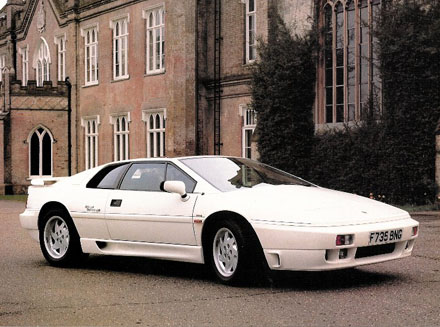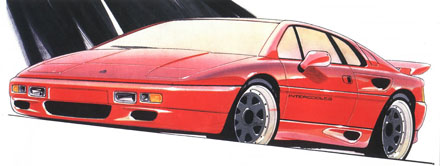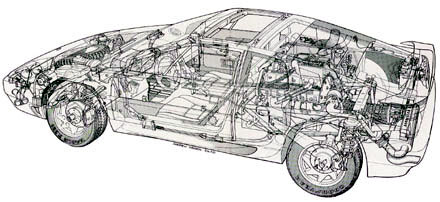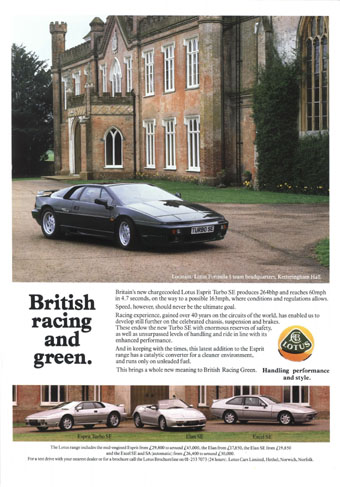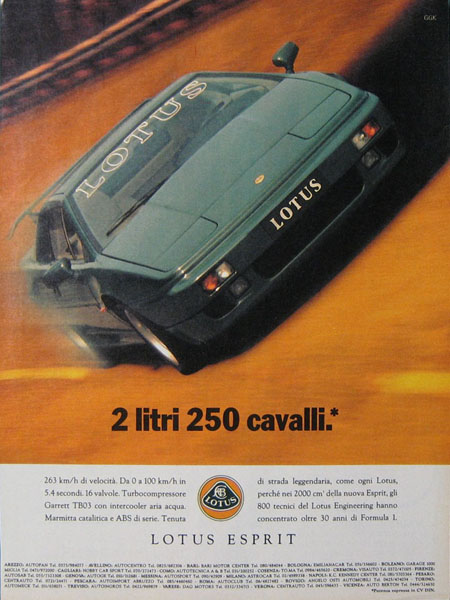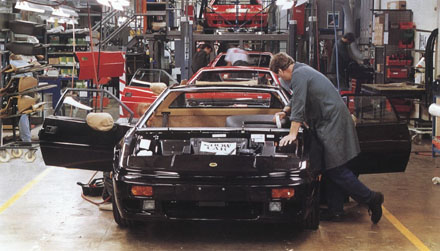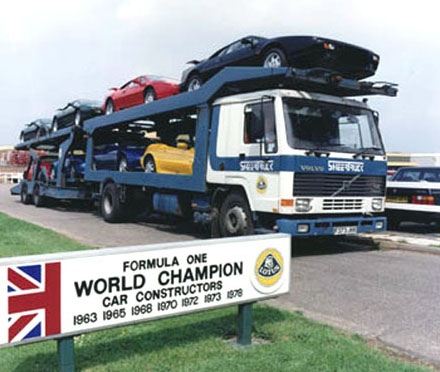
Lotus
Esprit SE
Esprit improvements — 1989-92
Turbocharged engine developments
The major leap forward came in mid-1989, when Lotus finally made
a charge-cooled engine available. To be frank, it was long overdue,
for although the company had been one of the very first to put a
turbocharged road car on sale, they had then fallen well behind
other manufacturers as they refined the technology further.
The
theory of charge-cooling, or intercooling, is simple enough. Compressed
air forced out of a turbo compressor is hot, and if it can be cooled
before entering the engine the volumetric efficiency is dramatically
improved. Cooling is done through a radiator — either an air-air
type, or an air-water type.
As might be expected, the Lotus installation was neat and effective.
In this case the charge cooler was mounted on top of the engine,
and the coolant was water, this being in a self-contained system,
circulated by an engine-driven pump to a front-mounted radiator.
This, however, was merely part of a comprehensive improve-ment package,
which also included Lotus/Delco injection and the ability to run
on lead-free fuel, a catalyst being standardized. Not only did all
this help push up peak power to 264bhp (DIN) at 6,500rpm, but there
was also a transient over-boost facility which allowed usage of
280bhp at 6,500rpm for up to 30 seconds of hard acceleration.
Two years after this charge-cooled engine had been launched, a further
variant was introduced, this being a 2-litre version, initially
for sale only in the Italian market. The rationale was fiscal, not
technical, for in Italy much higher motoring taxes were applied
to cars with engines of more than 2,000cc.
There were precedents for this move — Ferrari, Maserati and
Lamborghini had all offered smaller-engined versions of their cars
from time to time, though in no case had sales come up to expectations.
The development cost of producing a smaller-capacity engine —
which actually used the self-same crankshaft as the original Type
907 engine had done in the Seventies — was small.
With the introduction of the charge-cooled turbo engine, Lotus claimed
the title of the world’s highest specific output for a road-car
engine (121bhp/litre), though this was not likely to be held for
long.
By the early Nineties the famous 16-valve engine had been on the
market for 20 years, but Lotus clearly thought more potential was
still locked in there. In 1992, as this book was being prepared,
the first of an entirely new design of aluminium cylinder block,
more rigid than ever before, was phased into production.
Lotus Esprit SE Cut Away
In
the spring of 1989, when the charge-cooled engine was put on sale,
Lotus also introduced a series of chassis and engine changes to
the Esprit. The ‘Eagle’ chassis, so called because of
the exclusive use of Goodyear Eagle tyres, which is easily identified
by its use of 1 Sin diameter front and 1 6in rear wheels, was standardized
on all Esprits at this time, but the derivative with the 264bhp
charge-cooled engine became the Turbo SE (SE = Special Equipment).
The cost was a massive £42,500.
The SE not only had far more performance — a top speed of
159mph and 0—60mph in 4.9sec, which was remarkable by any
standard and equal to the performance of the Porsche 911 Turbo of
the period, but there had been further changes to the aerodynamics.
At the front there was a deeper front ‘bib’ spoiler,
the sills and their associated air intakes to the engine bay had
been reprofiled and, for the first time on an Esprit, there was
a small free-standing spoiler on the tail. Air conditioning and
a tilt/removable glass sunroof were also standard.
Lotus
Esprit SE Advert
Inside
the cockpit, there was more obvious luxury —perhaps an attempt
to justify some of the extra cost of the car. As Autocar & Motor
stated in its road test: ‘The SE’s all-leather cabin
has more of a “quality” ambience than the regular Turbo’s,
an impression helped along by the large slab of burr elm surrounding
the instruments and switches ...‘ This, by the way, was another
enthusiastic road test: ‘With the Turbo SE, Lotus has made
a break for the big time and has succeeded admirably in all the
most obvious respects. To many eyes the Esprit has always looked
the part and now those looks are matched — even surpassed
— indeed. The SE is fabulously rapid and enormously capable
The next batch of important changes came in the autumn of 1990,
effectively for the start-up of the 1991 model year. This was the
point at which the normally-aspirated Esprit finally died, and when
a whole series of model name changes confused the historians, particularly
if home market and export market titles were compared.
The most important mechanical improvement was that three-channel
ABS anti-lock braking was finally adopted —though not the
power-assisted steering for which the pundits had been nagging for
some time — while for the British market this signalled the
point at which three different models were briefly available. Note
the model names — carefully:
Esprit 215bhp, Dellorto carbs £34,900
Esprit S 228bhp, Lotus/Delco injection £38,900
Esprit SE 264bhp, charge-cooled, Lotus/ Delco injection £46,300
The Esprit received substantially changed bodywork in 1988, offering
a more rounded profile as well as improved aerodynamic drag. Several
variations of rear wing for both the SE and Turbo were to be seen
over the next few years. The Esprit SE in 1992 guise (right) with
its dramatically high-mounted wing supported by short struts over
the tail of the body and long arms extending from the back of the
cabin.
By this time, however, the Lotus factory and the Lotus dealers could
no longer give the Esprit their full attention. They were too bound
up in the front-wheel-drive Elan, which had been on volume sale
since April 1990, to think of much else. This was also the point
at which British economic recession began to bite in earnest, and
when Lotus should have realized that the Esprit was beginning to
look expensive. Perhaps this also explains why the Esprit S had
such a short life — for it was dropped after only a year.
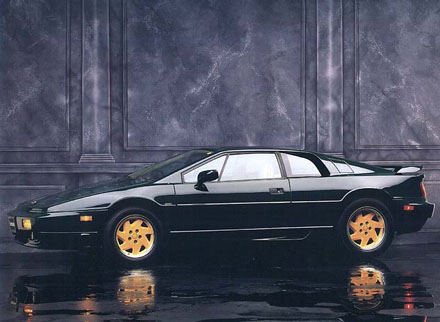
Special Edition Lotus Esprit SE
Twelve months later, and at a point when the front-wheel-drive Elan
still appeared to be selling very well indeed, more Esprit changes
were phased in. Not only was there a very significant improvement
to the cabin packaging of all types, but the SE model received an
extrovert new styling package which was claimed to reduce understeer
and raise the top speed.
From this point, all Lotus cars were provided with a three-year
unlimited-mileage warranty — experienced, not to say cynical,
Lotus owners thought this was likely to be a very expensive deal
for Lotus! — and no doubt partly to allow for this the UK
prices were raised yet again, with the price of the flagship SE
ni.odel soaring to £48,260.
Somehow or other the cabin had been repackaged and made more spacious.
Compared with earlier cars there was an extra 5.6in of headroom,
1 .6in more legroom and up to 3.2in more clearance between the seat
cushion and the steering wheel rim. A repositioned cabin/engine
bulkhead made the cabin 1 .2in longer overall. There was a revised
pedal box which gave shorter pedal movements and the centre tunnel
had been slimmed down to allow wider seats to be fitted.
Added to this was the provision of doors which opened by an extra
1 Sdeg — and if this does not sound much, it equated to an
extra 9in at the rear end of the doors.
The principal visual changes were only applied to the SE type, the
official reasons being twofold: to add front-end downforce to cut
the understeer, and to improve rearward visibility. The glass-back
which had featured on X180 types since 1987 was abandoned, the original
small spoiler of the SE was no longer fitted, and in their place
was a larger and free-standing rear aerofoil, mounted on pylons.
To balance this, at the front there was an extra rubber lip under
the existing ‘bib’ spoiler.
Lotus claimed that the overall effect was to improve downforce at
higher speeds, to cut the drag and to raise the top speed to no
less than 165mph.
Click on image to enlarge
Lotus Esprit SE Show Car on the assembly line at Hetthel
Even so, by mid-1992, when the Elan was suddenly killed off and
the last Excels had also been built, the Esprit had faded quietly
into a limited-production backwater all of its own. Yet again sales
in the USA had collapsed, and the British recession had hit hard
at sales of all high-performance cars, resulting in Esprit production
being cut back to no more than five cars a week.
By 1992 the Esprit Turbo SE had been further modified, with a more
spacious interior. It had also been given a large and aerodynamically
efficient rear aerofoil to improve its stability. But it was a short-lived
model, for early in 1993 this S4 version was unveiled, with an even
smoother profile and important chassis changes which were to transform
the Esprit's handling at a cost of a somewhat firmer ride.
Lotus Esprit SE's leaving the Hethel factory
Taken from Lotus Since the 70s by Graham Robson
